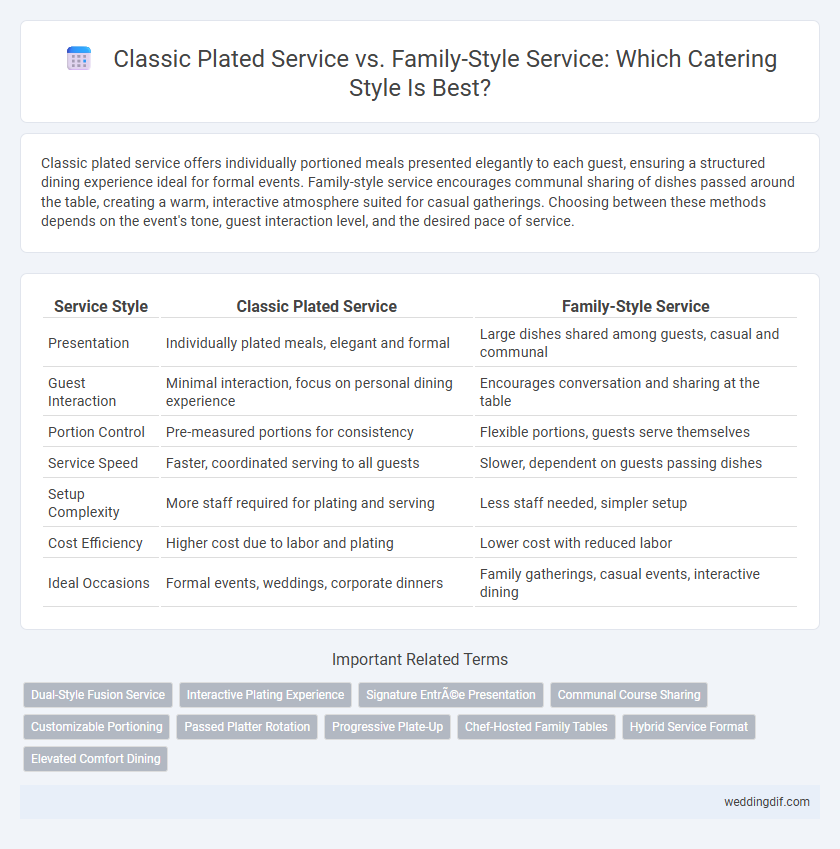Classic plated service offers individually portioned meals presented elegantly to each guest, ensuring a structured dining experience ideal for formal events. Family-style service encourages communal sharing of dishes passed around the table, creating a warm, interactive atmosphere suited for casual gatherings. Choosing between these methods depends on the event's tone, guest interaction level, and the desired pace of service.
Table of Comparison
| Service Style | Classic Plated Service | Family-Style Service |
|---|---|---|
| Presentation | Individually plated meals, elegant and formal | Large dishes shared among guests, casual and communal |
| Guest Interaction | Minimal interaction, focus on personal dining experience | Encourages conversation and sharing at the table |
| Portion Control | Pre-measured portions for consistency | Flexible portions, guests serve themselves |
| Service Speed | Faster, coordinated serving to all guests | Slower, dependent on guests passing dishes |
| Setup Complexity | More staff required for plating and serving | Less staff needed, simpler setup |
| Cost Efficiency | Higher cost due to labor and plating | Lower cost with reduced labor |
| Ideal Occasions | Formal events, weddings, corporate dinners | Family gatherings, casual events, interactive dining |
Understanding Classic Plated Service in Wedding Catering
Classic plated service in wedding catering involves individually plated meals served directly to guests by waitstaff, ensuring precise portion control and elegant presentation. This method allows for a curated dining experience with multiple courses, often including appetizer, entree, and dessert, tailored to the couple's chosen menu. Classic plated service enhances formality and sophistication, making it ideal for weddings that prioritize a refined and structured dining atmosphere.
What is Family-Style Service? A Modern Catering Option
Family-style service in catering features large platters of food placed at the center of each table for guests to serve themselves, fostering interactive and communal dining experiences. This modern catering option promotes flexibility in portion sizes and diverse menu selections while enhancing social engagement among guests. Catering companies offering family-style service often emphasize fresh, seasonal ingredients and customizable menus to accommodate event themes and dietary preferences.
Presentation and Aesthetics: Plated vs. Family-Style
Classic plated service delivers a refined and elegant presentation with individual portions artfully arranged on each plate, enhancing visual appeal and portion control. Family-style service creates a warm, communal atmosphere by presenting dishes in large, decorative platters that encourage sharing and interaction, emphasizing abundance and rustic charm. Both approaches prioritize aesthetics differently: plated service highlights meticulous detail, while family-style emphasizes inviting, shared displays.
Guest Experience: Formality vs. Interaction
Classic plated service offers a formal dining experience with individually plated meals presented to each guest, emphasizing elegance and personalized attention. Family-style service encourages interaction and a communal atmosphere by allowing guests to share dishes passed around the table, fostering connection and conversation. The choice between these styles impacts the overall guest experience by balancing sophistication with social engagement.
Menu Variety and Customization in Each Service
Classic plated service offers precise menu choices with individually portioned dishes, allowing high customization for dietary restrictions and presentation preferences. Family-style service emphasizes shared platters, encouraging a varied menu with multiple dishes that foster communal dining and flexible selection. Menu variety in plated service caters to detailed guest preferences, while family-style enhances customization through diverse shared options that accommodate group tastes.
Timing and Flow of the Wedding Reception
Classic Plated Service offers precise timing with each course served individually, ensuring a smooth and controlled flow that keeps the wedding reception on schedule. Family-Style Service encourages a more relaxed pace, allowing guests to share dishes and interact, which may extend meal duration and impact event timing. Choosing between these services depends on the desired balance between efficiency and communal dining experience at the wedding.
Service Staff and Logistics: Requirements for Each Style
Classic plated service demands a higher ratio of skilled service staff to efficiently deliver individually portioned dishes directly to guests, ensuring timely and precise presentation. Family-style service requires fewer servers but necessitates expertise in coordinating shared dish placements and refills, emphasizing smooth table flow and guest interaction. Logistic considerations for plated service include pre-plated meal preparation and strict timing, while family-style service involves managing communal dish distribution and replenishment schedules.
Cost Considerations: Plated Versus Family-Style
Classic plated service typically incurs higher labor costs due to individual plating and serving requirements, increasing overall catering expenses. Family-style service reduces staffing needs by allowing guests to serve themselves from communal dishes, thus lowering labor costs and minimizing food waste. Choosing between plated and family-style catering depends on budget constraints and the desired dining experience, with family-style often offering a more cost-effective option for larger gatherings.
Dietary Restrictions and Guest Preferences
Classic Plated Service ensures precise portion control and accommodates dietary restrictions by allowing guests to choose specific menu options tailored to allergies or preferences, minimizing cross-contamination risks. Family-Style Service offers a communal dining experience but requires careful coordination to label dishes clearly and provide separate options for guests with dietary needs to prevent accidental exposure. Both styles necessitate diligent communication with catering staff to respect guest preferences and maintain food safety standards throughout the event.
Choosing the Right Catering Style for Your Wedding
Classic plated service offers a formal dining experience with individually plated courses, ensuring precise portion control and elegant presentation favored at traditional weddings. Family-style service encourages a warm, communal atmosphere where guests share large platters, promoting interaction and a relaxed vibe ideal for intimate celebrations. Selecting the right catering style depends on the wedding size, venue logistics, and desired guest experience, balancing formality with the level of personal engagement.
Classic Plated Service vs Family-Style Service for Catering Infographic

 weddingdif.com
weddingdif.com